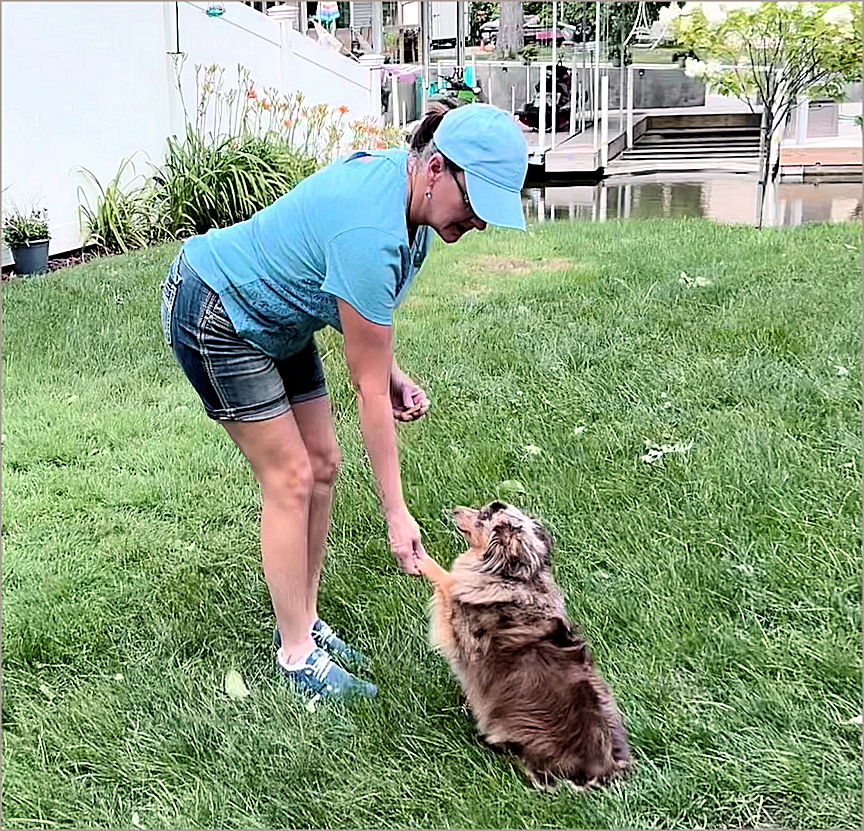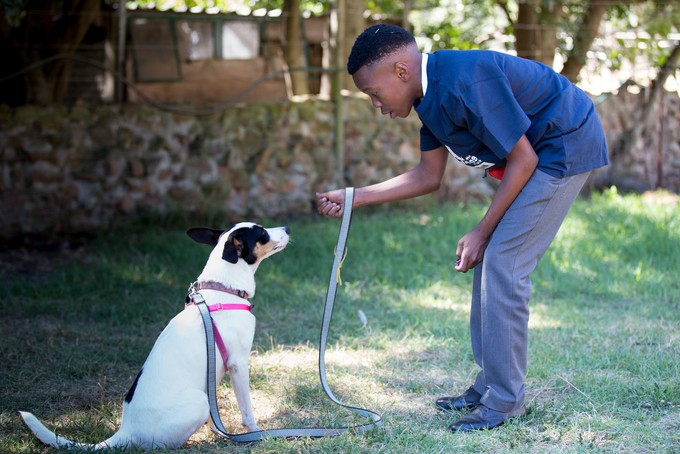PLEASE NOTE: Dog Garden Flags are currently unavailable. Please check back later. Thanks for your interest.
Training Dogs: Tips, Tricks and Housebreaking
Welcome to Dog Training: 101. Training dogs has never been easier. We'll deliver the tricks, you supply the treats.
Teaching new tricks is a great way to bond with your four-legged friend. Your reward is a well behaved dog that can keep the neighbors entertained for hours and his reward is making you happy... and the treats, of course.

Tricks: Here are the basic rules for training dogs.
- Limit training to around 10-15 minutes per session.
- Be patient
- Use a positive and friendly tone
- Remember that dogs learn at different paces
- Offer lots of praise and treats
- Keep it fun
Training dogs is simple if you have the right tools.
All you'll need is plenty of patience, a dog who loves treats and a good training method.
Training your dog should be done in a positive manner. Harsh methods or yelling will hinder progress and could cause your dog to retreat from training altogether. This goes double for housebreaking.
Need treats? Check out my easy, original, no bake dog treat recipe!
Training Dogs To Sit

This one is more eaily taught and learned, but it's important that your dog will "sit" even when you're not holding treats. Once the trick is learned, accomplish obedience with simple praise and offer positive reinforcement like a pat on the head and a "good dog".... and the occasional treat from time to time as well.
Voice Command: "Sit"
Step #1: Kneel or stand one or two feet from your dog and make sure that he's in the standing position. Say "sit".
Step #2: Gently push on your dogs rear end to coax him to sit as you're saying the voice command. Keep repeating it until he's sitting.
Step #3: Say "good sit" enthusiastically when he's all the way down and offer him part of the treat. Keep praising him until he stands up again.
Repeat step #1 and give him a few seconds to respond. Repeat the voice command 3 times or so, giving him a few seconds to respond each time.
Repeat steps two and three.
Your dog should go down a little easier each time, eventually going down as soon as he hears the command... without any physical encouragement from you.
Training Dogs To: Shake, Wave And Lie Down
 This is me training my rescue dog, Joy to shake. Joy is a miniature Australian Shepherd.
This is me training my rescue dog, Joy to shake. Joy is a miniature Australian Shepherd.

This work by Brooke Faulder is licensed under a Creative Commons Attribution-ShareAlike 4.0 International License. To use this image, please provide a link back to this website.
It's appropriate to teach "Sit" before training your dog to shake or wave. Once he's comfortable sitting on command, and has assumed the sitting position, the other tricks will come easier.
Training dogs to shake is as easy as training dogs to sit.
Step #1: For this command. Have your dog assume the sit position. Say the word "shake" and hold your hand in a position where the dog can easily reach it with her paw. Say the command a few times.
Step #2: Once you've repeated the command a few times, lift your dogs paw and enthusiastically say, "good shake" and offer a small food reward immediately, repeating "good shake" as long as you're holding her paw.
Step #3: Gently place her paw back on the ground. Repeat the command, giving her time to respond. If after a few times, she has not started raising her paw on her own, try again in an hour or so.
Make sure to say "good Shake" as soon as your dog raises her paw on her own. Be enthusiastic with your praise, but not so boisterously as to scare her.
Advanced Tricks: If "shake" comes easily and you're feeling confident in your dog training abilities, train your dog "left shake" and "right shake" using the same method. A little more challenging, but a great way to gain some positive interaction time with your best friend!
If shake (or another command) doesn't come easily, never punish the dog. This will only hinder future training. Limit training sessions to no more than 10-15 minutes, especially if your dog is showing signs of needing a break.
Training dogs to lie down works the same as teaching your dog to sit. Sit should be learned first.
Once your dog is in the sitting position, say "lie down". Force your dog into the lying position by gently lowering her front paws to the ground in front of her. Praise her by saying, "good lie down" and offer a small food reward. Repeat until she's doing it on her own or shows signs of needing a break.
Once "lie down" is learned, train your dog to "play dead".
How To Train Dogs To Wave
Training dogs to wave is similar to shake, but "shake" needs to be learned before wave can be taught. Training wave can be any verbal command you'd like, for instance, "bye bye", "wave bye", "say hello", or whatever.
To train your dog to wave, say the "wave" command, but hold your hand it the shake position. Wait for your dog to lift her paw, then move your hand to a little higher position.
Say good "good wave" and offer a small food reward immediately.
Repeat this a few times, raising your hand slightly each time until the dog is raising her paw over her head to reach your hand. Don't forget to praise her by repeating "good wave".
After a few times, try the "wave" command without holding your hand in the shake position, and instead wave at your dog. Don't be discouraged if she doesn't catch onto this right away. She will eventually.
Remember your dog is eager to please you and also eager for the treat reward, but a dog's attention span can be as short as a few minutes and relentless training can seem like a punishment to a dog that's lost interest. Be patient.
During training sessions, give your dog other commands she's already learned, like "sit" to instill confidence and break up any monotony.
Training Dogs - House Training
Housebreaking can be a long and tedious process for a small breed dog. It's altogether possible to house train any breed if you have the right tools* coupled with the correct method, and patience, most importantly.
Because house training is a vital part of the relationship you share with your dog, it's extremely important to be consistent and start as early as possible.
Whether your dog is a puppy or an adult rescue dog, it can be trained. But because of the extreme importance of doing this the right way, here are a few things that will help you* along the way.
House training does not need to be difficult.
Your dog should be taken out:- First thing every morning
- During or immediately after play time
- Immediately after having a meal or a drink of water
- Every night before bed
- Once every hour during the day (this goes for puppies and newly acquired rescue dogs)
- Every time you catch them trying to potty in the house
When you take your dog out, she should be on a leash. Keep tiny bites of food to offer near her leash so you wont' forget it, or in your coat pocket. Walk her around the yard until she's done her business. It may take a while. Occasionally say, "go potty" in a friendly, but not overly enthusiastic tone.
It's important she's on a leash so that you can praise her and offer a food reward immediately once she's done her business. Don't wait until you're back inside. Say "good potty outside" gently, but also cheerfully while she's going. Repeat the praise until she's done. Offer her the food reward and repeat the verbal praise. Take her back into the house when you're sure she's finished.
Never take your eyes off of her in the house. Tether your dog to you if you have to, to keep her in your eye sight.
When you take your dog back out on subsequent potty walks, visit the same spot where she did her business on the prior trip. Occasionally say, "go potty". Be Patient.
Once back in the house, as soon as you see her preparing to squat or lift his leg, say "no" and immediately take her outside. Say "outside" as soon as you open the door and begin walking out, EVERY time. It's a tedious and time consuming process, but the reward will eventually be a dog who understands, "outside" and then eventually understands, "good potty outside".
Training Dogs: Crate Training
*** Important To Remember ***
Dogs can be housebroken using the crate training method as long as they're not forced into a crate with another dog or into a crate that's too large or too small.
As a general rule, 2 dogs should not made to share the same crate. This is especially true during house training. Even litter mates who might eventually thrive by sharing one crate, should have their own during house training.
It's also extremely important that crate time is limited to very short intervals during the day, especially if the dog is crated at night to sleep. At night, set an alarm for 6-7 hours, the maximum amount of time a puppy should be expected to hold it.
Training dogs proper crate etiquette works best when the dog spends only a couple of hours per day in the crate. If you work long hours everyday, consider hiring a dog walker. This will prevent neurotic bahaviors. It's detrimental to the mental and physical health of a dog to spend long hours everyday in a crate.
Locking a dog in a bathroom for long hours is also setting him up for failure and a host of neurotic behaviors, like barking and chewing. Just as you would not want to be locked in a small room without visual access to the goings-on in other parts of the house, neither does your dog.
Do not leave your dog in a fully covered crate. Crate covers might work well as a temporary anti-stimulus tactic to reduce stress, but in everyday life, it prevents air conditioning in the rest of the room from reaching your dog. In a heated house, a fully covered crate can become a sweltering sauna with no air flow.
An uncovered crate offers your dog a safe space and gives him visual access to other parts of the house. As long as his crate time is limited, your dog will feel safe in a crate and will not mind being in it for short periods.
If you decide to use a crate for bed time, etc., you can find safe and practical crates that also add style to your home*.
Once your dog is housebroken, consider using barriers instead of a crate, like this Five-Way Mounting Gate* to prevent access to other rooms in your house for times when you need to have them contained. There are even extra wide gates with walk thru doors* like this one for large doorways.
Crate training works for many dogs and puppies because a dog's natural instincts tell him not to eliminate where he sleeps, but this only works when he's not forced to hold it longer than he is able to.
Forcing your puppy to spend too much time in the crate will result in a dog who becomes comfortable eliminating in the crate.
Training Dogs is hard work. Don't forget to treat your yourself... and your dog! We have a whole page full of neat gift ideas with your four legged friend in mind!
Learn more about me, my art, the mission of this site and Rescue Dogs Are Better here.
We also welcome you to contact us if there are any other questions we can answer for you about anything you saw or read on this site.
While shopping for dog training supplies, please support pet stores like Petsmart, who've decided to no longer support the puppy mill industry and has instead dedicated it's focus to finding homes for shelter pets! Many other stores have followed this example, so please support any pet store who's chosen to end their relationship with puppy mills.
Through their adoption program, Petsmart alone has saved the lives of nearly 3 million homeless pets. Petsmart also has a great program for training dogs. Be sure to check it out the next time you're there.
Help Support Our Mission
Support this site by sharing it with a friend. Every page of this site is dedicated, first and foremost, to de-stigmatizing rescue dogs and spreading awareness about puppy mills.
So please share one of the pages of this site with your friends on social media. You can also give me a like below! That helps, too!
*As an Amazon Associate I earn a small amount from qualifying purchases if you click on and subsequently purchase a product you find on this site.
 An at-risk teen learns to train a rescue dog. The pair are helping each other through a program aimed at building confidence in kids. Training also strengthens the dog's chances of finding a forever home. A great idea for any community!
An at-risk teen learns to train a rescue dog. The pair are helping each other through a program aimed at building confidence in kids. Training also strengthens the dog's chances of finding a forever home. A great idea for any community!
New! Comments
Leave us a comment if you have something you'd like to share or add to what you just read here. Or contact us with questions or comments.